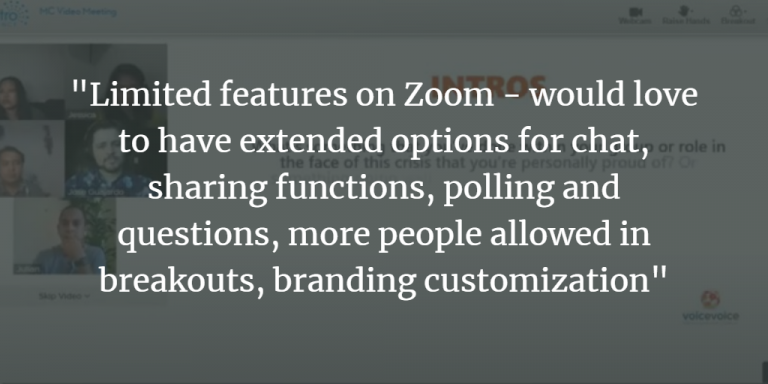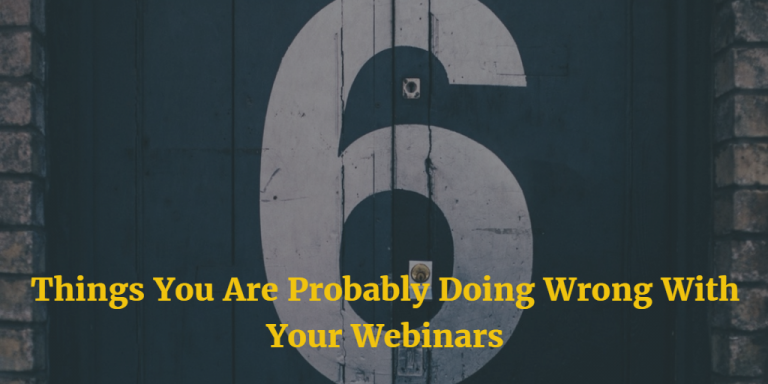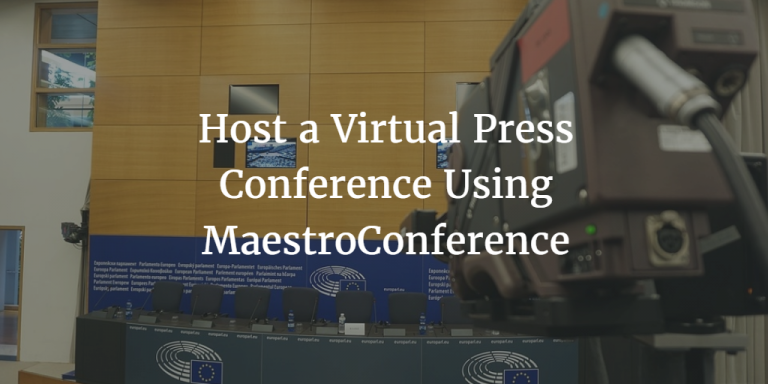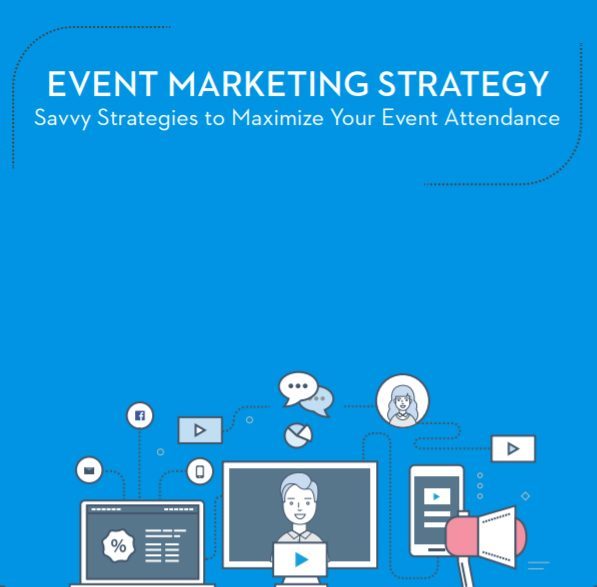How to Evaluate & Analyze Any Webinar Software
At MaestroConference, we’ve seen thousands of customers aiming for specific results with their webinars. There are multiple webinar options available, so the goal of this post is to help you, our readers, navigate them and find the webinar platform that will create the optimal results for your organization.
Please note, we had originally shared this information via a downloadable whitepaper (which is still available online here if you prefer the PDF version), but we want to make sure our blog subscribers, many of whom may have never visited our company website, are able to benefit from this deep dive into webinar software.
With that said, the following ideas will be addressed in this lengthy post:
- Results that webinar hosts are seeking
- Key metrics for webinar programs
- Successfully evaluating a webinar provider
- Engaging participants during the event
- Driving actions and achieving desired results
Desired Results From Your Webinar Efforts
Most webinar hosts seek very similar outcomes, including, but not limited to:
- Increased attendance at their events
- Attendees enjoying the event, being impacted and feeling inspired
- An increase in measurable actions by attendees during or after the event (such as volunteering, making a donation, or purchasing a program)
- Simple and practical ways for attendees to commit to action and be accountable to each other
- Motivation for the audience to return for future events
- Increased word of mouth and referrals to future webinars
Common Problems With Your Webinar Efforts
Unfortunately, the typical webinar, regardless of the technology used, when facilitated in a “traditional way” has the following problems:
- Few people register and fewer attend, even after much marketing and promotion
- Those attending report lackluster satisfaction and very little learning
- They have low “action conversion rates” (follow-through actions, such as purchases)
- Many people don’t return to future events
- There’s zero “viral buzz” and people don’t talk about the event with their friends
One might wonder how to transform a run of the mill webinar into an awesome event. We’re here to help…
Below, we’ve provided a framework to help you maximize your webinar efforts by illustrating how to evaluate a webinar solution—such as MaestroConference, WebEx, GoToWebinar, FreeConferenceCall, Instant Teleseminar, or the myriad of other options—to see if it has the capabilities necessary to recruit, inspire, and motivate.
We’re looking at both what technology to use and how to use it effectively. Great technology, used poorly, simply yields poor results. In fact, technology only enables great events; it doesn’t create them. We’ve learned some things that any host should consider when looking at webinar software and the types of interactions those platforms enable among participants.
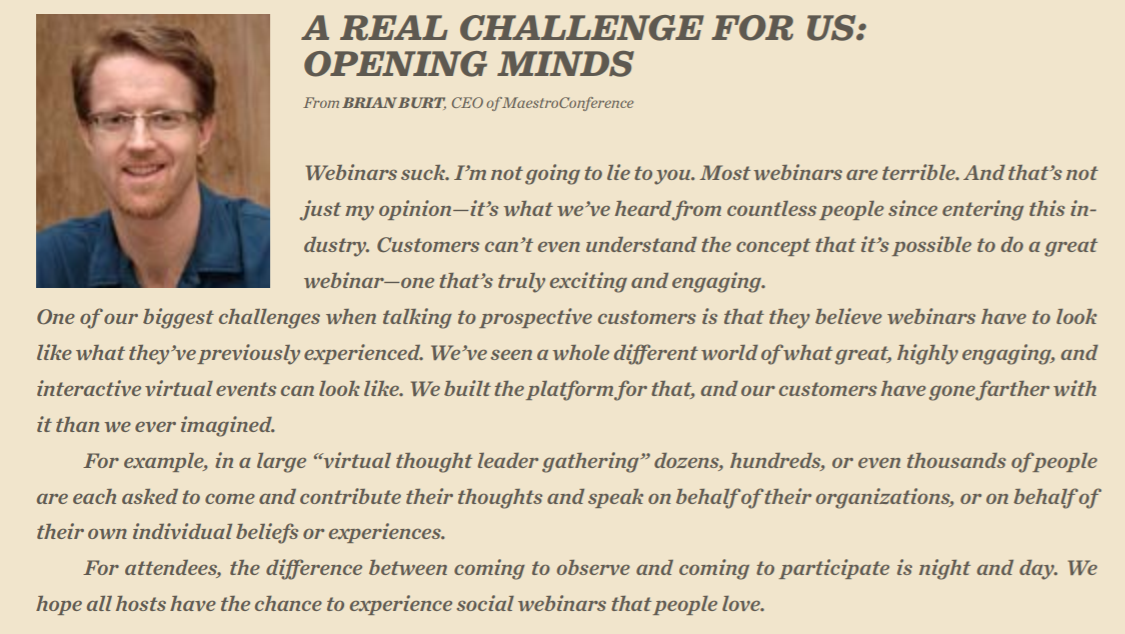
The 4 Factors To Analyze Any Webinar Software
There are four factors we believe drive the results that webinar hosts usually seek. A feature checklist, while important, will do little to help webinar hosts understand these results. What will help are the following metrics worth tracking and monitoring closely:
Factor #1 – Participation
When your audience is actively participating in your event, they’re doing more than just attending, they are being involved in the discussion. In other words, they’re not simply observers. They feel compelled to contribute, and they believe they have a stake in the outcome of the conversation.
Metrics worth tracking for Participation: How many people attend multiple events? How many tell others about an event afterwards? Do participants speak to the host and/or one another? How much do people feel like they are “watching” versus feeling they are “part of the event”?
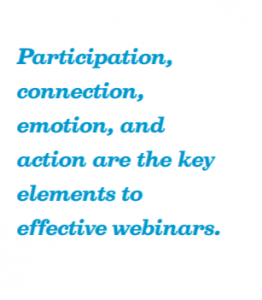
Factor #2 – Connection & Relationships
People feel personally connected with the presenters, the host organization, other attendees, the cause, and sometimes even with the global community formed around the topics discussed. They develop an interest in continuing a relationship with the host organization and with other attendees.
Metrics worth tracking for Connection & Relationships: How many people continue to stay connected with someone they met during the webinar? Are any willing to invest their social capital in promoting the next event?
Factor #3 – Emotion
Before, during and/or after your event, people feel uplifted, awakened, or challenged. An active emotional state increases retention of information and ups the likelihood that attendees will return for future events.
Metrics worth tracking for Emotion: Do people easily recall the information from the webinar? Do they feel inspired by the content? Do they share stories or experiences from the event with friends after the webinar is complete?
Factor #4 – Commitment & Action
People take the opportunity during the presentation or webinar to vow to do something to further the mission—be it becoming a member, purchasing a product or service, or giving time to volunteer. They commit to take some kind of action. With the right webinar software, the technology enables your audience to act on their promise immediately.
Metrics worth tracking for Commitment & Action: How many people take action during the event? How many make commitments that stick, during the event?
Now that we’ve identified the four factors to analyze any webinar program and the metrics worth tracking for each of them, let’s explore these factors more closely.
Factor #1: Participation
Webinar hosts say they want people to “participate” in their webinars. What does that mean?
At one extreme, hosts of traditional webinars consider simply watching a presentation “participating”, even though it consists of zero active involvement. These same hosts might consider the conference “interactive” if they have a short Q&A session and a small sampling of the people ask questions. That is, maybe 95% have a completely passive experience, and the other 5% interact for less than one minute each. This level of participant engagement is far short of the type of active participation that drives the metrics and results webinar hosts typically want, which explains why many webinar efforts don’t deliver the ROI their hosts initially anticipated.
At MaestroConference, we take a much closer look at what those attending actually do, because it’s crucial for driving learning, action, and connection. A group learning study in the Journal of Educational Psychology notes, “The level of constructive activity [people engaged in] was the strongest predictor of achievement.” With that in mind, we have come up with the following scale:
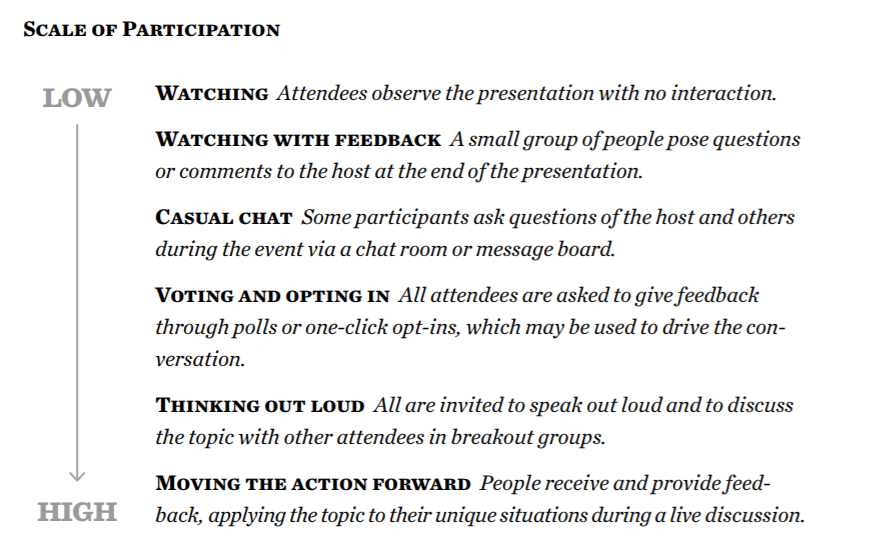
When attendees have an opportunity to think actively, speak out, articulate an action step, or get feedback on their situation or thoughts, the experience feels personal—even with hundreds of people attending the event. Those with a stake in the conversation remember the joy and level of understanding they felt in being included with their peers around questions that can truly create change.

Practical Application and Attendance Metric
Jesse and Sharla Jacobs, owners of Thrive Academy, a firm specializing in growth strategies for holistic organizations, shifted from using a traditional webinar presentation format (the first level on the scale) to a format of high participation. Each attendee had the opportunity (in a breakout session) to speak about their business, their questions, and the steps to apply the day’s topic to their situation—and to give and receive feedback.
Participants were invited to stay on the call after the webinar was done to continue to “mastermind,” or share the learnings from the valuable experiences they each have running their business.
Over a six-month period, the hosts reported a roughly 350% increase in attendance at their webinars, which they attributed directly to using a more participatory approach.

Factor #2: Relationship & Connection
Attendees come together to rally around a cause when the context of the conversation inspires them to participate, and relationships and relationship building are a powerful draw for people who are actively involved in making things happen. With a webinar software that fosters socializing, interaction and engagement among the audience members, a tremendo us amount of relationship building and connection can occur during a virtual event. Unlike a traditional webinar, with a “talk and listen” format, contributions are welcome and new ideas drive the conversation.
us amount of relationship building and connection can occur during a virtual event. Unlike a traditional webinar, with a “talk and listen” format, contributions are welcome and new ideas drive the conversation.
Meaningful conversations build relationships that extend far beyond the conference. We’ve heard people report that their lives changed profoundly after attending a social webinar event, saying they literally found their friends, business partners, collaborators, or even their fiancée (really!) in a breakout discussion. Many individuals expressed that they didn’t know there were so many others who shared their values.
Creating Connection
Asking an inspiring question at the start of the conversation is one method for inviting participants to connect more deeply, opening up minds to what is possible. Breaking up the main room into small groups can make it easier for people to participate freely and to get to know one another better. Through brainstorming with others who share similar values, a sense of ownership of the conversation is created.
More breakout groups can follow, but connection can take place during the main presentation too. When the host expresses passion for the topic through words, tone of voice, and visuals, it captivates the minds of attendees. Participants who feel like they are having an inspiring conversation are more apt to contribute by asking questions and offering their own ideas. This creates a sense of intimacy—like a fireside chat, rather than a web conference.
In a recent event with Deepak Chopra, a participant commented that he “felt like Deepak Chopra was in the living room with me.” Following that particular presentation, people were still talking in their breakout groups for more than an hour after the presentation ended.
An effective webinar platform provides these tools to help deepen connection:
- The host can call on people by name
- Participants can see the faces of the people they are talking to
- Breakout session capability allows small groups to share freely
It may seem hard to tell, at first, if participants feel connected to the conversation—but it’s actually very measurable.
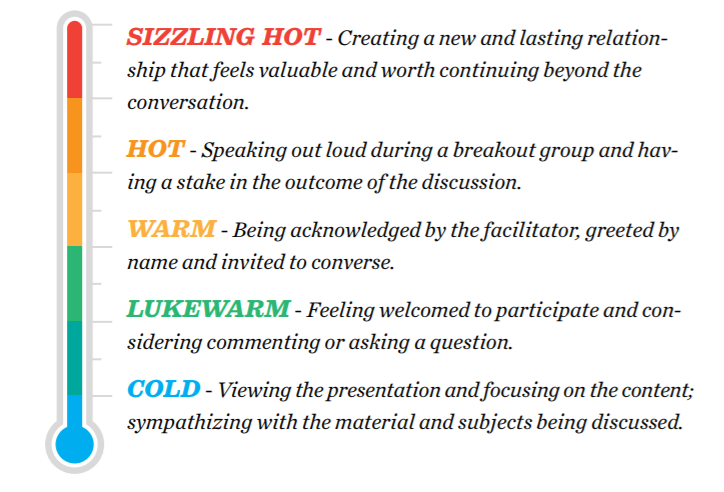
Factor #3: Emotion
Webinar hosts hold events with a specific goal in mind, whether it be an action, learning, or relationship. Emotion plays a key role in achieving these goals. When a participant’s emotions are heightened, the amygdala, or emotional center of the brain, interacts with the hippocampus, increasing the likelihood of retention.
If the brain is in an emotional flatline state—typical when a person is watching television due to boredom, or being present but not interested in a webinar—learning is inhibited. Learning is an emotional activity, as is a decision to move into action, and there’s no dispute that the process of forming relationships is rich with emotion. The host who promotes these activities is one whose presentation is likely to be a catalyst for change.
What Creates Emotion?
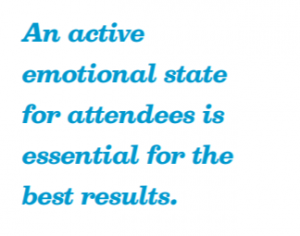
Hosts often make the mistake of trying to entertain or add emotion simply by being charismatic. It’s hard to really grip people and hold their attention when they’re simply viewing or listening. For every viral, truly emotionally engaging YouTube video, there are millions (perhaps billions) that aspire to be that viral and engaging. It’s not that a webinar host shouldn’t try to give an engaging talk, just that one shouldn’t lean on talk alone. Webinar hosts can reliably add the essential emotional connection with these more accessible means:
- Personal involvement Participants apply a general framework to their own personal situation. For example, they brainstorm ideas on next steps to take in their own lives to achieve spoken goals. The host can bring this about by breaking participants into small groups to discuss a relevant topic.
- Aspirational Reflection People consider what is possible in relation to the topic and community. For example, in a webinar related to fitness, a host may ask, “What would your life look like if you followed the healthy lifestyle we’re talking about? What would be the impact on your family?” This gives attendees the opportunity to apply the topic to their own life experiences, to form an emotional tie, and then to discuss it with others by speaking it out loud in breakout groups.
- Internal Reflection People who attend a social conferencing event with an internal focus are reminded of issues that are important to them and why they want to see change happen. Often, a certain vulnerability is present that serves relationship building, trust, and openness. The host can let participants generate content by coming up with their own questions or discussion topics, either prior to or during the webinar. This isn’t appropriate for every event, but for certain events participants find such reflections powerful.
- Team Dynamic A friendly contest or group collaboration usually enhances emotions such as camaraderie, shared responsibility, a desire to help others, or gratitude for others’ care. For example, participants can brainstorm solutions to a common problem and then vote on the best one.
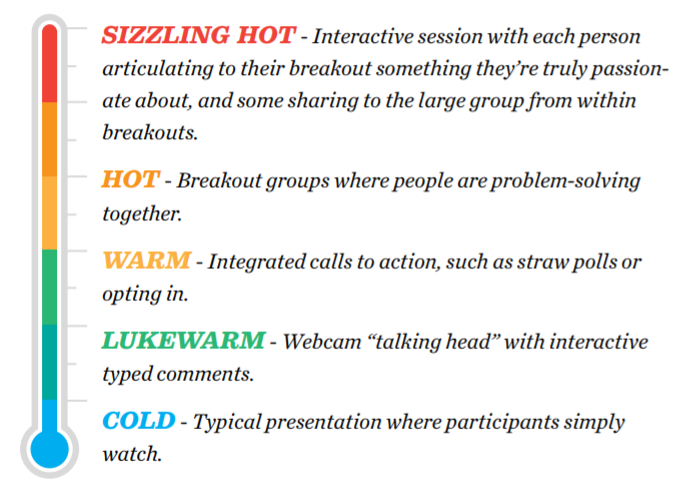
MaestroConference’s webinar software makes it possible to create an aspirational collective where people in the conversation can consider these questions:
- What could we do together?
- What change could we make?
- How can I change my life/change the world?
The desired emotions vary tremendously from event to event. So, when evaluating technologies, it’s more important to look at what communication types are available.
Factor #4: Commitment & Action
There’s an African proverb that states, “When you pray, move your feet.” Furthering a mission requires action from those involved. Concrete action is almost always the desired result of a presentation; it is not simply to gain viewers. With many events we’ve seen here at MaestroConference, attendees are so inspired by the virtual event they take action during the event: making a donation, signing up to volunteer, purchasing a program, committing to recruit others, etc. So, we think it’s important to evaluate webinar software to see what options are available for commitment and concrete action within the webinar interactions.
Forms of Commitment
- Opting into an email list. It’s best if attendees can signal interest as easily as possible during the event. One-click technology allows them to do so with just one button push on their keyboards or phones. In a recent MaestroConference event with Deepak Chopra, 75% of attendees signed up for weekly e-mails using this option. To achieve this kind of result, we recommend looking for a technology that allows not only button-push signaling within the webinar, but also lets the presenter capture the name, email, and phone number of those signaling and copy those into a spreadsheet or database.
- Volunteering or pledging. This is committing to perform an action or make a purchase, through electronic means. For example, in an event with Michelle Obama supporting the president’s 2012 re-election campaign, 80% of attendees made a pledge to volunteer in support of the campaign, again using the one-click technology described above.
- Making a verbal commitment to individual action. During a breakout group, an attendee says out loud what he or she is going to do—specifically, to act in regards to the mission discussed in the webinar. During his webinars, Jack Canfield asks attendees, “What’s the one action you will commit to this week to move you towards your goal you identified earlier today?” Attendees respond verbally with a specific action, which becomes more motivating than simply typing a response. It seems more “real.” MaestroConference can provide individual consulting to customers about customizing questions to achieve their most desired results. Finding a platform and company that excels at this individualized support is key.
- Conducting commerce interactions. The webinar host asks who is ready to sign up for a service or buy a product. An assistant invites each interested person to a private one-on-one breakout to complete the transaction. For example, a business coach takes signups for a platinum mastermind session right during a prospect event. A new customer gives her his credit card information to purchase coaching sessions. The coach and client have a one on one “laser coaching” session right then, while the content of the presentation is still fresh in both of their minds. It’s commerce interaction plus the commencement of a teaching program. Using a platform with private breakout room technology is fundamental to ensure privacy for the buyer and no disruption to the ongoing webinar. MaestroConference, as the leader in high-interactivity webinars, has a U.S. Patent on this feature.
CONCLUSION
With a new awareness of what is possible, it’s important to consider what participants can experience. Web conferencing providers, to varying degrees, are successful at offering ways for attendees to participate, become emotionally invested, create relationships, and take action. Achieving desired results often requires a combination of features.
CONTACT US
If you’re interested in how an engaging, interactive webinar software can enhance your global events, we hope you will be in touch. MaestroConference provides live demonstrations, free training for new customers, and one-on-one consultations for qualified hosts. If you’d like to deepen your understanding of our capabilities and what they can do for your organization, we look forward to speaking with you.
Email sales@maestroconference.com
Register for a free trial account at MaestroConference.com
Call us at +1 877 414 1515
We’d love to help you decide what webinar platform is best for your business, and support you through the process if you determine that social conferencing advances your mission.


